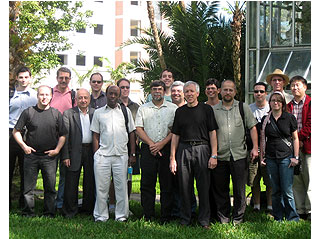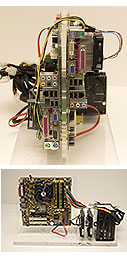|
 |
The 2nd Southeastern CMS Physics Analysis Workshop was held in Miami at the FIU campus the 7-9 of February, 2007. The purpose of the workshop series is to develop collaborative relationships between CMS physicists that have regional ties, share resources and expertise and/or have other common interests. The workshops have been organized to both showcase activities that enable or enhance CMS physics analysis and hold tutorials that describe how to actually do analysis at CMS.
The February workshop was divided into presentations focused on physics analysis activities and tutorials that dealt with using the CMS software and resources.
|
 |
 |
Figure 1. Attendees from UF, FSU, FIU, FIU, Vanderbilt,
and Brazil at the CHEPREO CMS Analysis Workshop |
|
|
| |
 |
Computations in High Energy Physics require a large number of parallel computers. The typical computer cluster uses 1U stacks of computers in racks, with each 1U unit having 4 CPU’s. There are two problems with these types of systems. High cost and inefficient cooling of cores. The FSU HEP group has recently put together a 40 CPU system of 64 bit Intel units at a substantially lower cost which avoids the heating problem.
The goal of this project is to extract the maximum performance per dollar, infrastructure costs included, optimized for university research groups. The installed cost of a forty CPU’s (Intel E6600 dual core), 2.4GHz, 64-bit cluster, including all the network components is $14K. The same hardware purchased through Dell costs about $36K. Each of our dual CPU’s includes 80GB HD’s, 2GB RAM. The cost per kSPECint2k (the CMS benchmark) is under $250. Some are on the Open Science Grid (OSG) while others are available to users with accounts on a cluster.

|
 |
|
| |
Research across the Americas moves fast, when high-speed
networking is the least of Physicist’s worries. |
 |
The CMS research community in the U.S. depends on collaborations to ensure good peer review, and fresh ideas to keep the quest for new elementary particles and novel behaviors of the fundamental forces going. That’s easy to do in the U.S. where researchers rarely have to worry about bandwidth and network availability challenges.
Before the NSF Office Of Cyber Infrastructure supported Western-Hemisphere Research and Education Networks – Links Interconnecting Latin America (WHREN-LILA ) project started in January of 2005. |
|
Priscilla Pamela is Venezuelan born and has been in the U.S. now for 9 years. Her interest in physics started in high school when she decided that she wanted to study astronomy in the United States. She came to Florida International University and was told in order to study astronomy you need physics. She started working on campus for the Nuclear Group here at FIU, and found that her interests shifted to nuclear and away from astronomy.
 |
 |
|
|
|
|
|
 |
|
 |
 |
| FEBRUARY 4-6 |
| CMS Workshop @ FIU |
|
 |
| FEBRUARY 26 - MARCH 2 |
| CMS Meeting |
|
 |
| MARCH 5-8 |
| OSG Tier 3 mH 5-8eeting |
|
 |
| MARCH 9 |
| CHEPREO Staff Meeting |
|
 |
| MARCH 9 |
| Draft Year 4 CHEPREO Annual Report due |
|
 |
| MARCH 29 |
| External Advisory Committee Meeting |
|
 |
| SPRING BREAKS |
| FSU [5-9], UF[10-17], FIU [19-23], CALTECH[18-25] |
|
 |
|
| |
|
|
|





